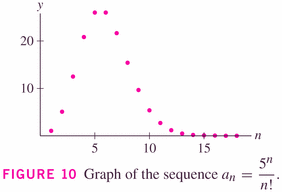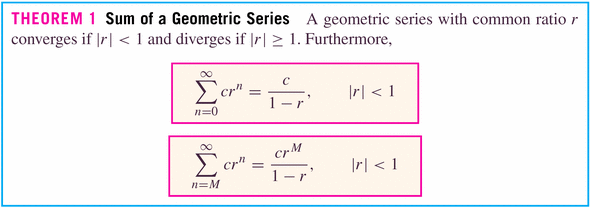- Your quiz is returned from last time.
- Some are struggling with notation.
- Look at your words. Can you translate them into unambiguous symbols? That's one of the reasons that mathematicians like symbols so much -- they're often cut and dried, when words aren't. For example, several of you spoke of "it" without a clear reference for "it".
- Your homework is returned.
- 4, p. 567
- 16
- 26
- Your quiz opportunity tomorrow will be over 11.3: The Integral Test
- A handout concerning series.
- Once we have some series in hand, we might want to start operating with them. In particular, as we saw in our very first series, we might want to add up the terms:

In particular, we expect that, if we throw in the
term, we should get
Such as sum is called an infinite series.
- The question which presents itself is this: what do we mean by this sum of an infinite number of terms? This is indeed curious.
- Here's how we make sense of that infinite sum:
- From the sequence
we define a new sequence
:
These are called partial sums. Notice that there are two indices running around, and that the limit refers to the summation's upper limit, not to the index of the sequence.
If
Then we say that
exists, and is equal to
. This justifies our probability distributions of the form
:
Because, in general,
This is an astonishing fact: we can think of an exponential function as a polynomial with an infinite number of terms. In fact, we can think of lots of functions this way (e.g. sines and cosines!). This is where we're headed in this class....
More formally,

Now geometric series are sufficiently important that it's useful to include that special case:

There's a really fun proof of the first part above, based on a trick. Let's have a look at it.

This theorem tells us that if a sequence isn't asymptotic to the x-axis, we can forget about its partial sums converging.
Finally, series behave the way we'd hope:

- Examples:
- #1, p. 735
- #4
- #15
- #17
- Beautiful spiral "proofs" of some infinite series
- #87
- From the sequence